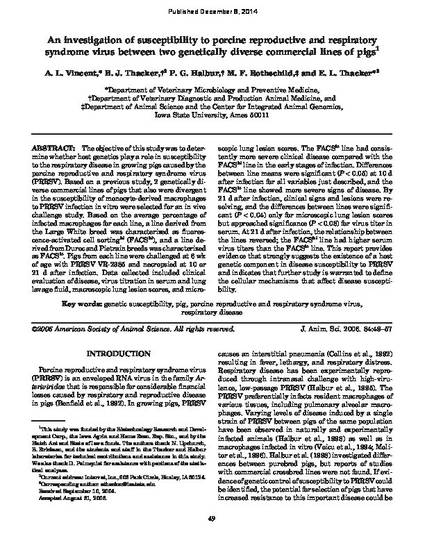
The objective of this study was to determine whether host genetics play a role in susceptibility to the respiratory disease in growing pigs caused by the porcine reproductive and respiratory syndrome virus (PRRSV). Based on a previous study, 2 genetically diverse commercial lines of pigs that also were divergent in the susceptibility of monocyte-derived macrophages to PRRSV infection in vitro were selected for an in vivo challenge study. Based on the average percentage of infected macrophages for each line, a line derived from the Large White breed was characterized as fluorescence-activated cell sortinghi (FACShi), and a line derived from Duroc and Pietrain breeds was characterized as FACSlo. Pigs from each line were challenged at 6 wk of age with PRRSV VR-2385 and necropsied at 10 or 21 d after infection. Data collected included clinical evaluation of disease, virus titration in serum and lung lavage fluid, macroscopic lung lesion scores, and microscopic lung lesion scores. The FACSlo line had consistently more severe clinical disease compared with the FACShi line in the early stages of infection. Differences between line means were significant (P < 0.05) at 10 d after infection for all variables just described, and the FACSlo line showed more severe signs of disease. By 21 d after infection, clinical signs and lesions were resolving, and the differences between lines were significant (P < 0.04) only for microscopic lung lesion scores but approached significance (P < 0.08) for virus titer in serum. At 21 d after infection, the relationship between the lines reversed; the FACShi line had higher serum virus titers than the FACSlo line. This report provides evidence that strongly suggests the existence of a host genetic component in disease susceptibility to PRRSV and indicates that further study is warranted to define the cellular mechanisms that affect disease susceptibility.
Available at: http://works.bepress.com/max-rothschild/22/

This is an article from Journal of Animal Science 84 (2006): 49, doi:/2006.84149x Posted with permission.